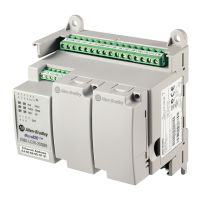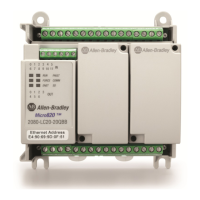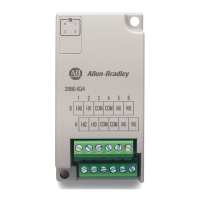
Do you have a question about the Allen-Bradley 2080-LC20-20QBB and is the answer not in the manual?
| Brand | Allen-Bradley |
|---|---|
| Model | 2080-LC20-20QBB |
| Category | Controller |
| Language | English |
Overview of Micro820 controller's physical characteristics and capabilities.
Details on the various status LEDs on the Micro820 controller and their meanings.
Information on the microSD card slot for project backup, restore, and data logging.
Details on the controller's combined RS232/RS485 serial communication port.
Information about the controller's 10/100 Base-T Ethernet port for network connectivity.
Details on using Connected Components Workbench for programming Micro800 controllers.
Features allowing modifications to a running project without going to remote program mode.
Explains the RMC feature for incremental logic modifications in a running project.
Discusses memory allocation and usage for Run Mode Change operations.
Details the constraints and restrictions when using the Run Mode Change feature.
Describes RMCC for changing controller address configuration during run mode.
Configuration steps for using RMCC with the Modbus RTU protocol.
Configuration steps for using RMCC with EtherNet/IP communication protocol.
Lists the various agency certifications the product has obtained.
Details the product's compliance with European Union EMC and Low Voltage Directives.
Guidelines and warnings for safely installing the controller in various environments.
Specifies requirements for enclosures and environmental conditions for controller installation.
Guidelines to prevent damage to the controller from electrostatic discharge.
General safety advice, including hazardous location approvals and power disconnection procedures.
Information on wiring safety circuits, including master control relays and emergency stops.
Key points regarding power distribution for the controller and associated devices.
Discusses isolation transformers, power supply inrush current, and power loss hold-up time.
Recommendations for managing heat dissipation for optimal controller operation.
Explanation of the function and installation of a Master Control Relay for safety shutdowns.
Guidelines for properly implementing emergency-stop switches in the system.
Critical guidelines for safe and effective controller wiring.
Specifications for wire types and sizes for controller terminal blocks.
Explains the importance and application of surge suppressors for inductive loads.
Strategies for reducing electrical noise interference in controller wiring.
Specific recommendations for wiring analog input and output channels.
Proper grounding procedures for shielded analog communication cables.
Illustrative wiring diagrams for sink/source, input/output configurations.
Table detailing wiring for digital input terminals and common connections.
Table detailing wiring for digital output terminals and common connections.
Diagrams and instructions for connecting serial devices to the controller.
Provides the physical dimensions for mounting the Micro820 controller.
Guidelines for maintaining adequate space between modules for ventilation and isolation.
Instructions for mounting the controller onto a standard DIN rail.
Steps for securely installing the controller using panel mounting screws.
Specific dimensions required for panel mounting the controller.
Procedure for establishing network communication via the controller's EtherNet/IP port.
Step-by-step guide for inserting and securing the microSD card in the controller.
Instructions for installing the optional Remote LCD module for controller configuration.
Lists the various communication protocols supported by the Micro820 controller.
Details the maximum number of simultaneous connections supported by the controller.
Explains the Modbus RTU protocol and its configuration for Micro800 controllers.
Describes the CIP Serial protocol for RS232 communication, often used with modems.
Information on using the ASCII protocol for connecting to various intelligent devices.
Details the Modbus TCP protocol for Ethernet communication.
Explains CIP Symbolic communication for easy HMI and device connectivity.
How to access global variables using CIP Symbolic addressing.
How the controller supports pass-thru for applications like program downloads.
Information on utilizing serial modems with Micro820 controllers.
Steps to configure the controller's serial port for different protocols like CIP Serial, Modbus RTU, or ASCII.
Detailed steps for setting up the CIP Serial driver in Connected Components Workbench.
Explanation of the parameters used for configuring the CIP Serial driver.
Step-by-step guide to configure the serial port for Modbus RTU communication.
Details on the parameters for configuring Modbus RTU communication.
Steps to configure the serial port for ASCII communication.
Guide for setting up IP addresses, subnet masks, and gateway for the Ethernet port.
Rules and guidelines for configuring valid IP addresses for the controller.
Information on using OPC with RSLinx Enterprise for data communication.
A general overview of how programs run and execute on the Micro800 controller.
Explains the four main steps of a program execution loop within the controller.
Discusses how controller activities impact program scan time and overall performance.
Describes variable states and LED behavior during power up and the first scan.
Details the memory specifications for different Micro800 controller models.
Provides recommendations and limitations for programming complex Micro800 applications.
Explains how only one session can access the controller at a time for configuration.
Details how to secure the controller with a password to prevent unauthorized access.
Discusses compatibility scenarios between software and firmware versions for password features.
Outlines workflows for uploading, debugging, and downloading to password-protected controllers.
Procedure to transfer a program and lock a second controller with a password.
Steps to back up and restore controller data to/from a memory module securely.
Procedure for recovering access to a controller when the password is lost.
Introduces the 2080-REMLCD module's features and capabilities as a text display interface.
Explains how the Remote LCD acts as a USB pass-through for workbench connectivity.
Describes the controller's I/O status and main menu operations via the Remote LCD.
Details the keypad operations and menu structure for navigating the Remote LCD interface.
Lists and describes the functions available in the Remote LCD's main menu.
How to create custom display screens using function blocks for the Remote LCD.
Information on performing backup and restore operations using the Remote LCD module.
Introduction to microSD card support for Micro820 controllers, including backup and data logging.
Details on how to back up and restore controller projects using the microSD card.
Explains the file structure created on the microSD card for backups.
How to configure controller settings at power-up using the ConfigMeFirst.txt file.
Configuration settings within ConfigMeFirst.txt to initiate firmware upgrades from microSD.
Identifies common errors and issues that can occur with the ConfigMeFirst.txt file.
How to use backup files to deliver project updates to customers via email.
Methods for restoring controller projects from microSD card backups.
Functionality for capturing and storing global/local variables with timestamps to microSD.
Details the folder and file structure used for storing data log information.
Explains the DLG block's inputs, outputs, status, and error codes for data logging.
Summarizes performance metrics and limits for data logging on Micro820 controllers.
Lists data types supported for data logging and recipe functions, with example formats.
Information on the Recipe feature for storing and managing lists of data.
Describes the file and folder structure used for storing recipe data on microSD.
Explains the RCP block for reading/writing recipe variables to/from microSD.
Provides step-by-step projects for using Data Log and Recipe function blocks.
Step-by-step guide to configuring and using the data log feature.
Instructions on how to retrieve data logs from the microSD card using Workbench.
Step-by-step guide to configure and use the recipe feature.
How to retrieve recipe files from microSD using Workbench or a card reader.
Provides detailed specifications for Micro820 controllers across different models.
Details electrical specifications for AC input signals for specific controller models.
Electrical ratings and contact data for the controller's relay outputs.
Information on duty cycle error characteristics for PWM output ports.
Analysis of data logging performance based on data payload and write times.
Details operating conditions, temperature, humidity, vibration, and ESD immunity.
Lists the product's certifications including UL, CE, C-Tick, and KC.
Explains the meaning of the various LED status indicators on the controller.
Describes the expected behavior of indicators during normal controller operation.
Lists possible error codes, their types, descriptions, and recommended recovery actions.
Provides steps to resolve recoverable faults.
Provides steps to resolve non-recoverable faults.
Instructions on how to access and save the controller's fault log.
A flowchart-based model to help diagnose and troubleshoot controller errors.
Information on what details to provide when contacting support for assistance.
Guide on how to update the controller's firmware using Connected Components Workbench.
Instructions for performing firmware updates using a microSD card.
Steps to modify the ConfigMeFirst.txt file for initiating firmware upgrades.
Guide to setting up communication between RSLinx and the Micro820 via USB and Remote LCD.
Instructions for setting, changing, or clearing controller passwords.
Explanation and procedure for forcing I/O values for testing and debugging.
A guide to using the Run Mode Change feature for making live logic modifications.
Compares the parameters and features of IPIDCONTROLLER and PID function blocks.
Details the arguments and their data types for the PID function block.
Lists and explains the error codes associated with the PID function block.
Explains the arguments and functionality of the IPIDCONTROLLER function block.
Step-by-step instructions for performing the autotune function for PID control.
Guidance on identifying and resolving issues during the PID autotune process.
Illustrates a practical application of PID control in a water level system.
Explains how Micro800 controllers map variables to Modbus addresses.
Details the address space and supported data types for Modbus communication.
Information on Modbus endian byte ordering for Micro800 controllers.
Information and contact details for obtaining assistance with product installation.
Procedure for returning products that are not functioning correctly.
How to provide feedback for improving the documentation.











